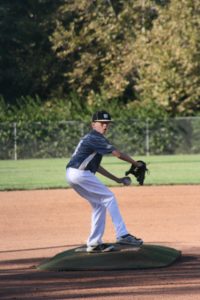
Every pitcher has a signature that’s unique to them. We believe in keeping that signature while teaching athletes efficient mechanics for velocity, control, and injury prevention. Unfortunately, many youth pitching coaches give instruction that can affect your young player’s signature.
While well-intended, the advice to break the throwing hand toward second and glove to the plate may go against a player’s natural pitching signature. Coaches far and wide believe straightening the throwing arm toward second base can increase pitching velocity. This is usually based on anecdotes, rather than real data.
Some players may benefit from this advice, to be sure. However, scientific research and motion analysis of some of the best MLB pitchers shows that the more accurate advice for players may be to create equal and opposite elbow angles after breaking hands.
What is Equal and Opposite? Why Does this Matter for Pitchers?
What do we mean by equal and opposite? Basically, we recommend players focus on making their glove arm and throwing arm mirror images of each other after breaking hands. If it feels natural for youth pitching athletes to make their arms straight, then that’s what they should do.
However, not all professional pitchers straighten their arms after breaking their hands. Instead, some players have a slight bend in their elbows, with their hands pointing toward the ground. Even some of the fastest pitchers in the game demonstrate this type of elbow angle.
Motion analysis shows that most professional pitchers do create equal and opposite, or mirrored, glove and throwing arms. They just may not be straight angles. So, if one elbow is bent, the other should be bent about the same amount. This can help players maintain balance throughout pitching delivery.
For example, imagine you’re trying to walk on a narrow curb. What do you do? Many people will have a natural response to put their arms out on either side of them to help with balance, much like a tightrope walker. When pitching, equal and opposite elbow angles can have a similar effect, making it easier for the player to stay balanced.
Why Equal and Opposite Isn’t as Easy as it Sounds for Youth Pitching Athletes
This sounds like simple advice, right? However, many youth pitching players may struggle with this. It may take some coaching and instruction for pitchers to achieve equal and opposite elbow angles.
The difficulty is that pitching gloves weigh more than baseballs. The standard weight for a little league baseball is five ounces. The average little league glove weighs in at one and a half pounds. This may lead to youth pitching players to have different elbow angles. However, gaining functional strength with a pitcher-specific training program can help with this.
At National Pitching, we offer scientifically-proven training for baseball pitchers. Our health-first program provides players with pitching lessons that help them continually improve from little league to the major leagues. To begin our advanced pitching program, find a pitching coach near you or get instant access to our comprehensive training video library by signing up for a membership today!
